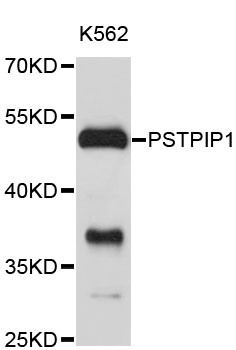-
Product Name
PSTPIP1 Polyclonal Antibody
- Documents
-
Description
Polyclonal antibody to PSTPIP1
-
Tested applications
WB, FC
-
Species reactivity
Human
-
Alternative names
PSTPIP1 antibody; CD2BP1 antibody; CD2BP1L antibody; CD2BP1S antibody; H-PIP antibody; PAPAS antibody; PSTPIP antibody; proline-serine-threonine phosphatase-interacting protein 1 antibody
-
Isotype
Rabbit IgG
-
Preparation
Antigen: A synthetic Peptide of human PSTPIP1
-
Clonality
Polyclonal
-
Formulation
PBS with 0.02% sodium azide, pH7.3.
-
Storage instructions
Store at 4℃. Avoid freeze / thaw cycles.
-
Applications
WB 1:500 - 1:1000
FC 1:20 - 1:50 -
Validations

Western blot - PSTPIP1 Polyclonal Antibody
Western blot analysis of extracts of K-562 cells, using PSTPIP1 antibody .Secondary antibody: HRP Goat Anti-Rabbit IgG (H+L) at 1:10000 dilution.Lysates/proteins: 25ug per lane.Blocking buffer: 3% nonfat dry milk in TBST.
-
Background
Involved in regulation of the actin cytoskeleton. May regulate WAS actin-bundling activity. Bridges the interaction between ABL1 and PTPN18 leading to ABL1 dephosphorylation. May play a role as a scaffold protein between PTPN12 and WAS and allow PTPN12 to dephosphorylate WAS. Has the potential to physically couple CD2 and CD2AP to WAS. Acts downstream of CD2 and CD2AP to recruit WAS to the T-cell:APC contact site so as to promote the actin polymerization required for synapse induction during T-cell activation (By similarity). Down-regulates CD2-stimulated adhesion through the coupling of PTPN12 to CD2. Also has a role in innate immunity and the inflammatory response. Recruited to inflammasomes by MEFV. Induces formation of pyroptosomes, large supramolecular structures composed of oligomerized PYCARD dimers which form prior to inflammatory apoptosis. Binding to MEFV allows MEFV to bind to PYCARD and facilitates pyroptosome formation. Regulates endocytosis and cell migration in neutrophils.
Related Products / Services
Please note: All products are "FOR RESEARCH USE ONLY AND ARE NOT INTENDED FOR DIAGNOSTIC OR THERAPEUTIC USE"
